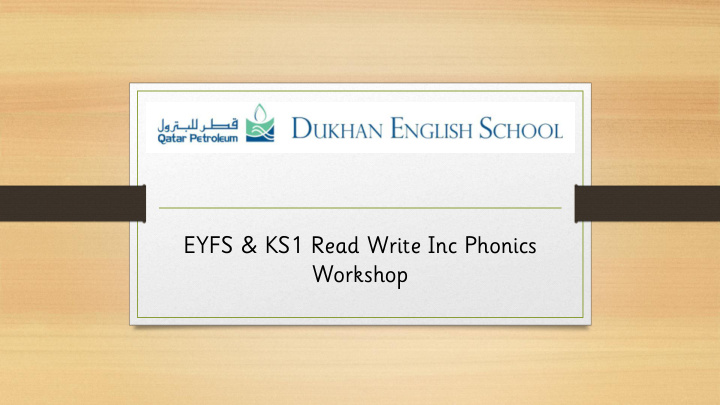



EYFS & KS1 Read Write Inc Phonics Workshop
What is phonics? • Words are made up of sounds, these are then merged together to make words • We have 44 sounds to make up all the words in the English language but we only have 26 letters which then complicates things • Sometimes they are singular letters, pairs or even sometimes in three e.g. a, ch, igh • There are actually 150 different ways to make up the 44 sounds which can make it complicated for children to read • In comparison it is easier to learn Spanish as they have 26 sounds and 24 letters
sat dress horse circle piece sleep happy dream he
How do we teach RWInc Phonics? • Phonics is taught systematically which means its taught in a structured way to all children • First we teach children one way of reading and spelling the English sounds • This is done by giving children a hook to learn the sounds in the form of a picture e.g. s - snake
How do we teach RWInc Phonics? Each lesson has a clear structure that is followed by all staff • 5 Principles – Purpose, Passion, Pace, Participation and Positive Teaching
How do we teach RWInc Phonics? • Children are taught the sounds in a specific order – m, a, s, d, t, i, n, p, g, o, c, k, u, b, f, e, l, h, sh, ck, r, j, v, y, w, th, z, ch, qu, x, ng, nk *Please refrain from using the letter names as this doesn’t support the reading process • If the children know the sounds below then they can read these books
How do we teach RWInc Phonics? • If the children know the sounds in set 1 and set 2 then they can read these books Set 1 sounds Set 2 sounds
How do we teach RWInc Phonics? • Children are then taught new ways of spelling the sounds • Children do not read books that include the spelling of the sounds they do not know RWInc will continue into year one, the children remain on the programme until they have learnt all • the sounds and can apply this knowledge to writing and reading fluently
How do we assess RWInc Phonics? • Children are formally assessed throughout the year and grouped accordingly based on their identification of sounds, fluency and blending of these sounds to read words Each child is individually assessed and their information is recorded to inform the teacher for groupings, next steps and gaps in their phonic knowledge
Helping at home… • Please read with your child everyday whether it is a library book or their reading book. Take 15 minutes to have quality time with a text • Practice the sounds at home (check the pure sounds video) and understand the importance of repetition Build strength in your children's fine motor control by cooking, playing with playdough or just simply • drawing • Read the green words, red words, nonsense words throughout the afternoon, evening and weekend • Visit a library and pick some books to share at home • Talk around the dinner table about your day • Share the love of reading openly at bedtime
Support for you at home… Ruth Miskin has a ‘Facebook’ page that will keep you updated on tips and ideas to support your child at home Ruth Miskin has range of very useful videos on ‘YouTube’ that can be accessed for free and will help with understanding the process and of course how to say the ‘pure’ sounds.
What do I need to know? Explore the room to learn about the specifics of RWInc and ask key questions to find out more •
Thank you for coming if you have any further questions please contact me – Miss Nadia Williams 36354 n.williams@des.qpschools.qa
Recommend
More recommend